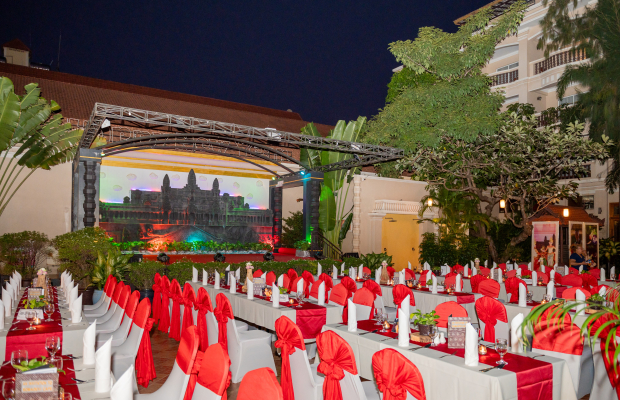1. APSARA DANCE SHOW (originating since Angkorian Period)
Involving a fragment of the Ramayana “the ancient Indian epic”, the Apsara Dance has had its roots in Hindu animism since the 1st century.
During the Angkor era (the reigns of King Jayavarman II to VII), this dance took on its own unique form, graceful movements, and deep meaning. By the 13th century, it was the typical Khmer than the Indian. The images of wanton dancers, adorned with gold headdresses and silken tunics and skirts, were carved on the walls of Angkor Temple and many other temples. Three thousands of Apsara images were found on the walls of the 12th-century court of King Jayavarman VII.
Over the centuries, classical Khmer dancing lent its influence to the classical ballet of the neighboring countries. Some of its postures and movements are similar to other Southeast Asian dancing. However, Princess Bopha Devi said, “The Khmer kingdom started its cultural tradition in the 8th century, 500 years before Thailand.”
Based on Khmer mythology on bas-relief on the walls of the Angkor Temple, all of Apsara dancers “heavenly women” were born from the foam surface of the ocean of milk when Devoda (heavenly beings) and Assura (demons) churned the ocean of milk with the gigantic Naga in search for the elixir of immortality.
This dance portrays Mera dressed in white for purity, dancing in her garden. She is accompanied by her handmaidens “Apsara”. They all produce flowers expressing great love of the people and the country.
The Apsara Dance is deemed to be a main part of the Royal Ballet of Cambodia, which was declared “Intangible Cultural Heritage of Humanity” by UNESCO on 7 November 2003, and it is particularly valued as a national art treasure.
2. BLESSING DANCE (Tep Monorum Dance Show)
The Blessing Dance is normally performed during official opening ceremonies, blessing to the King, to the Country Leader and offering wishes to the Audience. In this classical piece, the lyrics and gestures describe the wishes of happiness. Flower petals are tossed gently from small trays as a way of blessing the audience and the event.
It is also called The Happiness of the Gods and Goddesses Dance, is also one of the most popular and beautiful dance in the court repertoire. It has also sometime performed as a dance of blessing to end a performance. The distinctive interweaving floor patterns of the Tep Monorum, as well as the complimentary relationship of male and female, in which the male is always on the female’s left, all reveal the importance of balance in Khmer social interaction. The chorus describes the erotic pursuit of the heavenly maidens by the male celestials as well as their harmonious union.
3. COCONUT SHELLS DANCE
The Coconut Shell Dance is <a Khmer traditional dancing with dancers knocking coconut shells together to sound sweet. It is truly held to mark the harvest season in Cambodia and to show a close romantic relationship between young men and women during the harvest.
4. GOLDEN MERMAID (Sovann Maccha Dance Show)
It is a name of royal dancing performance, a traditional Cambodian dance. It narrates the encounter of Hanuman and Sovann Maccha during the construction of the causeway to Lanka in Reamker, a Cambodian version of Indian epic Ramayana.
In this dance, Hanuman, the white monkey general, led an army of monkeys to build a bridge across the ocean to rescue the captive princess. As they piled up stones for the bridge, the stones mysteriously disappeared. Hanuman dived into the sea to investigate and discovered a beautiful golden mermaid, named Sovann Machha, who had ordered shoals of fish as her entourage to bring out the stones obstructing their traffic. When he saw her, he fell in love with her and soothed her. With his clairvoyance, Hanuman persuaded her to order shoals of fish to transport stones to rebuild the bridge, leaving an appropriate passage in the center to let her and her entourage go through. After they rebuilt the bridge successfully, he disguised himself as big to fill that passage and ordered his army to cross this bridge to fight against the enemies. He eventually defeated Rahwana and liberated the princess.
5. FISHING DANCE
The Fishing Dance is a dance symbolizing love and romance of the young people in a fishing quarter. Love and romance are favorite themes in Khmer stories and dance. In the traditional Cambodian society, young people are carefully watched and do not have many opportunities to get to know one another. However, the fishing quarter is one place where they have the chance to meet.

 reservations@somadeviangkor.com
reservations@somadeviangkor.com 
